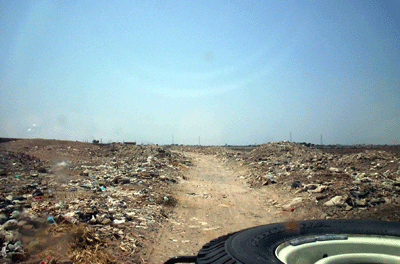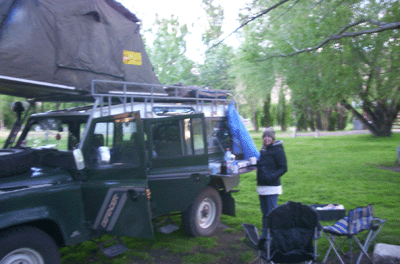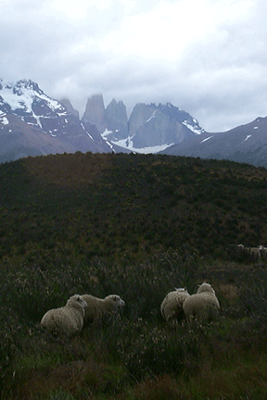
. . . LAND ROVER OVERLAND EXPEDITION
| Home | |
Journals
|
|
VALUED SPONSOR |
|
This was the expedition where everything went wrong - and where we
severely strained some friendships. For the reader, it’s a great
case study of pitfalls that can be avoided when planning an expedition. Shortly after we started dating I asked Stacey where in the world she
most wanted to visit. "South America" she said. In the summer
of 2003 she was worn down at work, and after finding out a friend was traveling
around the world decided she would love to join his group on a 3 month
expedition. Jim was taking a long break from the rat race and wanted to
do South America around the same time that Stacey wanted to take a break,
it made perfect sense. I proposed that they take the Land Rover and Stacey
didn’t need any convincing. She had done six weeks of the Around-the-World
expedition and had loved it. It worked out that there would be four of
them, Stacey, Jim, John, Christine. I made up a budget based on previous
expeditions and after mulling the potential costs they decided that’s
what they wanted to do. I would pop down and join them for a few weeks. Expedition Rule 1: Make an early plan to share the work. Sharing the preparation work gives everyone a better sense of being involved
and committed to the process. As a leader, if you take on the majority of
the work, it’s too easy to be criticized later when things go wrong (and
they will). Plus, the team will feel less like owners and more like renters.
And that is an important mindset that can come back to haunt you. Expedition Rule 2: Have a signed travel contract and deposit. Since this was a trip for my wife and friends, I simply explained that
doing a vehicle-based expedition carried a lot of risks and asked for
their assurance
that they would take care of the truck. In fairness to them, without
the benefit of a complete description of all the risks that they faced;
customs
delays,
mechanical breakdown, accident, etc., they made their own assumptions.
In my mind I’d given them a complete briefing, in their mind they agreed to
a set of unclear risks. All this would have been avoided with an up-front deposit
and clear and explicit contract. Halfway through the process, as the planning and preparation was taking
its toll, I looked out the kitchen window at the Land Rover sitting
in the driveway
and realized that no matter what happened on the trip, there was no
way that it would return to the driveway in as good a condition as
it was
right then.
For any guy who has loved a car, you understand what I’m talking about.
Long weekends of polish and minor repairs. Customized changes. All added up
to a value that was more than the engine and sheet metal on wheels. I did some
research and emailed the group… “Sending down the Land Rover is
probably not the most cost effective idea – it’s cheaper and easier
for you to rent a 4x4 pickup in Patagonia…” The group consulted
on the costs but were resolute, they wanted the real Land Rover experience.
So despite my misgivings, the truck was packed in a container and shipped down
to Ecuador. Having organized several expeditions, I’ve found that partners
on the expedition are almost always quite willing to sign a travel contract – because
travelers are optimists by nature and minimize risks. Getting a deposit
is harder but possible, because it is the intention of everyone to
get it back. The contract is their commitment to the team, and the deposit
is
for everyone’s
peace of mind. You will be able to let slide the little disputes
on the road, knowing
that at the end of the trip the deposit is there to make up the cost
overruns. For partners on an expedition, the deposit represents their
maximum exposure.
Worst case, they can walk away and leave that money behind. It’s
much more comforting knowing that they have an upper cap to their
liability, and
haven’t signed up to share a potentially unlimited amount of
expense should the worst happen. If your travel partners are unwilling
to sign a contract or provide a deposit - re-think your own exposure
and how you want to run the trip. Expedition Rule 3: Don’t make promises
in the heat of the moment. Having the truck stranded in Guayaquil was a challenge. A few months
prior to the start of the trip, we found out Stacey was pregnant.
There was
no way she could do the whole trip, high altitudes in Peru and
Bolivia were
medically unsafe. So we scaled down her portion from three months
to six weeks, I decided
to go down with her, and we planned to poke around through Patagonia.
Now, one week prior to departure, I had to change the tickets to
Ecuador – 5,000km
to the north. I tried talking Stacey into relaxing in Santiago for five days
while I did a solo 1,000km/day sprint south - but she would have none of it.
Pregnant or not, she was going to do her share. We were both embarrassed about
the disaster at the port. After all, this was my truck, I had made the arrangements,
and Stacey’s friends had lost a huge chunk of time on their trip. We
were determined to get the truck south and get things back on track. Unfortunately, we made a bad situation worse by sending a series
of emails promising to make things better. “We will meet you south of Bolivia” – but
then the parts didn’t arrive in Ecuador and we sat for several days. “We
will meet you in northern Chile” – but then I got food poisoning
in northern Peru and lost critical driving time. “We will make up the
costs for this first half of the trip that you lost” – but then
as our own trip went from bad to worse we realized we would be paying over
$20,000 for six weeks of brutal desert driving and a close miscarriage … and
that was a bitter pill to swallow. When you are on the road, a lot is going to go wrong. I had
a fender bender in Brazil on a prior expedition that put
a gouge
down the
side of another
car. We negotiated for an hour on the side of the road and
finally the other driver
settled for $300 cash. As a team, we all agreed to pay an
equal share – even
though I was driving. Later on in the same expedition, when one of the women
rolled the truck in Patagonia and demolished it, the whole team shared in the
costs and hassle of the insurance claims, repairs, and ongoing travel on public
transport. On my teams I draw the line at personal negligence or “bad
faith” – in other words, if someone on the team lies, cheats, steals,
or is grossly irresponsible, they are personally responsible for any resulting
expense (and in the travel contract, there is a provision to have the removed
from the team with the loss of their deposit if their actions endanger the
rest of the team). I’ve found that something is almost always going to go wrong on a tough
expedition. Many times there is no knowing who will be at the wheel when it
happens. Instead of blaming the individual, it is most healthy for the team
to jointly cover the cost and work together on finding the solution. This is
the difference between having expedition participants (or “renters”)
and have expedition partners (or “owners”). Expedition Rule 4: A vehicle giveth freedom, and it taketh
freedom away. Unfortunately a vehicle can also be an anchor. On my
Africa ’99 expedition
I was almost stranded in Kenya when the border guards refused to recognize
my visas. On the Around-the-World expedition we limped into the repair shop
a dozen times with a broken thermostat, disconnected ignition wiring, pulverized
suspension mounts, blown tires, smashed windows, cracked air conditioning tubing,
and other mechanical failures. Two times we found ourselves stranded in the
middle of nowhere, literally in the desert with no clue how to escape, and
using the satellite phone were able to get advice from our sterling mechanics
to jury-rig the truck enough to get going again. In the afterglow of my last expedition, I failed to
paint the full picture of everything that could go
wrong. And
Jim, John,
and Christine,
got
a run of bad luck. Starting with the broken rear
wheel in Guayaquil which cost
them a week. And later when they did get the truck
for the second half of their
trip, they had several days of hassle trying to cross
a border. And the final straw, the main fan belt
broke in
the middle
of Patagonia causing
the engine
to overheat and warp the cylinder head. When making a decision about whether or not to use
a vehicle I use the following rule of thumb – you
will cover distances twice as fast as the bus travel
times published in Lonely Planet. But you should
expect to be either in a repair shop or stranded
at some border for about 25% of your driving time.
Net, net – expect
to move about 25% faster than a bus. It’s
a winning proposition. You move fast and get to
do the great little side trips. But what you gain
in mobility and speed, you will have to pay for
with up front preparation and on the road repairs. Expedition Rule 5: Owning isn’t the same as renting – charge
accordingly. Partners pay a full share of total costs. Up
front costs like expedition gear, maintenance,
shipping,
insurance,
Carnet, satellite phone – that is all
added on to the running costs of the trip. Most importantly though, they also
share the risks. That means when the trip is conceived, everyone agrees that
they will live with the consequences of the trip no matter what happens. This
is where the contract comes in handy. Where expeditions often get into trouble
is during the trip, when something happens, and responsibility is perceived
differently. On the Panamerican expedition, we had very
high up front costs mostly due to shipping.
And unexpectedly,
with
the engine blowup,
we had
some substantial
post-trip costs as well. For Jim, John and
Christine, it was a bad deal. They
had paid several thousand dollars to cover
up front costs, had gotten no use of the
truck in
the first
half of the
trip because
of the
breakdown in Guayaquil,
and had suffered an engine blowup after five
weeks of driving in the second
half. So instead of ten weeks of driving,
they got
only five, and had the added cost of public
transport. For Stacey and I the trip was a
disaster. Taking six weeks off work at
our high-powered
consulting firm
(McKinsey) is difficult
to do,
and in
this precious amount of time instead of
enjoying Patagonia we spent five weeks on
hard core driving just to get the truck
to the drop off point where it would be ready
for Jim
and crew
when they
returned
from their
Christmas break to
resume the second half of their trip. We
almost had a miscarriage in Peru from the
bumpy roads,
the altitude,
and the 40
degree desert heat.
The
place Stacey
wanted to see most, Torres del Paine… we
were able to spend 3 hours before we had
to move on. Stacey cried from the unrelenting
pace as the pregnancy
progressed. And for me, the Land Rover
arrived back in Canada minus the expensive
tool set (“lifted” when
Jim and company took the truck in for repairs
on the broken fan belt) and with a blown
engine that had to be re-built. For a trip that was originally budgeted at
$4,000 per person for three months (I was
not in the
original budget) – Jim, John, and Christine ended up
paying $4,000 each for only five weeks of Land Rover use, and Stacey and I
ended up paying $11,000 each for five weeks of driving. From a $12,000 budget
the trip ended up costing $31,000 including repairs back in Canada. A friend of mine was preparing for a UK
to South Africa expedition in his Defender
110
Camel,
and decided it
would be a good
idea for the group
to
join a Land
Rover driving course prior to departure.
One of the women was driving across the
face of
an incline
and
panicked,
she turned
uphill sharply
and the
vehicle rolled over and over down the
hill. Of the crew of four, two went to hospital.
The Defender was a write off. The expedition
never happened. Since there was no contract,
the leader
was left with
a mountain of gear,
a wrecked
vehicle, and no money. Another potential disaster is if you
have an accident in a foreign country
while
on a Carnet
du Passage.
Even if
the vehicle
is
completely wrecked,
you must still pay to have it towed
and containered back to your home country.
If you don’t, you will be liable for illegally “importing” the
vehicle into a foreign country, you will forfeit your Carnet deposit, and will
be subject to the duties payable in that region. Some countries are not a problem
since they have low or no import duties. Others can be a catastrophe (e.g.
Egypt with a 300% import duty, Brazil is 200%). Summary I've had a mixed bag of expeditions. On my first, in Africa, things went
right when they could just as easily have gone wrong. There was little
planning and a lot of luck. On my second, around the world, there was a
year of planning for a one year trip. We had our share of bad luck, but
the trip still came off well. On the Panamerican, I didn't take the full
set of precautions, and without a contract,
when tough times hit all the participants felt like they were shortchanged. Overland expeditions are still a life changing way to travel and I will
definitely plan a fourth - but this time wiser and even more fully prepared. For more information visit the Expedition
Planning section. |
All rights reserved




